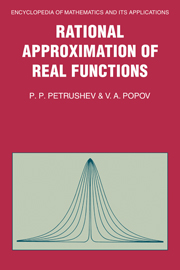Book contents
- Frontmatter
- Contents
- Preface
- Acknowledgements
- 1 Qualitative theory of linear approximation
- 2 Qualitative theory of the best rational approximation
- 3 Some classical results in the linear theory
- 4 Approximation of some important functions
- 5 Uniform approximation of some function classes
- 6 Converse theorems for rational approximation
- 7 Spline approximation and Besov spaces
- 8 Relations between rational and spline approximations
- 9 Approximation with respect to Hausdorff distance
- 10 The o-effect
- 11 Lower bounds
- 12 Padé approximations
- Appendix: Some numerical results
- References
- Author index
- Notation and subject index
2 - Qualitative theory of the best rational approximation
Published online by Cambridge University Press: 05 August 2013
- Frontmatter
- Contents
- Preface
- Acknowledgements
- 1 Qualitative theory of linear approximation
- 2 Qualitative theory of the best rational approximation
- 3 Some classical results in the linear theory
- 4 Approximation of some important functions
- 5 Uniform approximation of some function classes
- 6 Converse theorems for rational approximation
- 7 Spline approximation and Besov spaces
- 8 Relations between rational and spline approximations
- 9 Approximation with respect to Hausdorff distance
- 10 The o-effect
- 11 Lower bounds
- 12 Padé approximations
- Appendix: Some numerical results
- References
- Author index
- Notation and subject index
Summary
The most essential problems in the qualitative theory of the best approximation are the problems of existence, uniqueness and characterization of the best approximation. Finally the problems connected with the continuity of the operator of the best approximation, or, as is mainly used, the continuity of the metric projection, are considered. In this chapter we shall consider these questions for the best rational approximation. The difficulties arise from the fact that the set Rnm of all rational functions of order (n, m) (see the exact definition in section 2.1) is not a finite dimensional linear space and the bounded sets in Rnm are not compact in C[a, b] or in Lp(a, b). Nevertheless we shall see that there exists an element of best approximation in C[a, b] and Lp(a,b) (section 2.1). Moreover in C[a, b] we have uniqueness and characterization of the best approximation by means of an alternation, as in the linear case (see section 2.2). Unfortunately in Lp(a,b), 1 ≤ p < ∞, we do not have uniqueness (section 2.3). In section 2.4 we consider the problem of continuity of the metric projection in C[a, b] – the metric projection is continuous only in the so-called ‘normal points’ (see section 2.4). In section 2.5 we consider numerical methods for obtaining the rational function of best uniform approximation. We should like to remark that we examine only the usual rational approximation.
- Type
- Chapter
- Information
- Rational Approximation of Real Functions , pp. 17 - 39Publisher: Cambridge University PressPrint publication year: 1988



